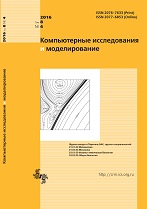|
MODELS OF ECONOMIC AND SOCIAL SYSTEMS
Relation between performance of organization and its structure during sudden and smoldering crises
E. A. Burlakov
Lomonosov Moscow State University, Faculty of Computational Mathematics and Cybernetics,
building 52, 1, Leninskiye Gory, Moscow, 119234, Russia
Abstract:
The article describes a mathematical model that simulates performance of a hierarchical organization during an early stage of a crisis. A distinguished feature of this stage of crisis is presence of so called early warning signals containing information on the approaching event. Employees are capable of catching the early warnings and of preparing the organization for the crisis based on the signal's meaning. The efficiency of the preparation depends on both parameters of the organization and parameters of the crisis. The proposed simulation agent-based model is implemented on Java programming language and is used for conducting experiments via Monte-Carlo method. The goal of the experiments is to compare how centralized and decentralized organizational structures perform during sudden and smoldering crises. By centralized organizations we assume structures with high number of hierarchy levels and low number of direct reports of every manager, while decentralized organizations mean structures with low number of hierarchy levels and high number of direct reports of every manager. Sudden crises are distinguished by short early stage and low number of warning signals, while smoldering crises are defined as crises with long lasting early stage and high number of warning signals not necessary containing important information. Efficiency of the organizational performance during early stage of a crisis is measured by two parameters: percentage of early warnings which have been acted upon in order to prepare organization for the crisis, and time spent by top-manager on working with early warnings. As a result, we show that during early stage of smoldering crises centralized organizations process signals more efficiently than decentralized organizations, while decentralized organizations handle early warning signals more efficiently during early stage of sudden crises. However, occupation of top-managers during sudden crises is higher in decentralized organizations and it is higher in centralized organizations during smoldering crises. Thus, neither of the two classes of organizational structures is more efficient by the two parameters simultaneously. Finally, we conduct sensitivity analysis to verify the obtained results.
Keywords:
crisis, crisis management, weak signals, mathematical modeling, simulation, agent-based modeling, organizational structures, Monte Carlo method.
Received: 03.02.2016
Revised: 16.07.2016
Accepted: 04.07.2016
Citation:
E. A. Burlakov, “Relation between performance of organization and its structure during sudden and smoldering crises”, Computer Research and Modeling, 8:4 (2016), 685–706
Linking options:
https://www.mathnet.ru/eng/crm21 https://www.mathnet.ru/eng/crm/v8/i4/p685
|

| Statistics & downloads: |
| Abstract page: | 175 | | Full-text PDF : | 81 | | References: | 32 |
|




 Contact us:
Contact us: Terms of Use
Terms of Use
 Registration to the website
Registration to the website Logotypes
Logotypes









 Citation in format
Citation in format 